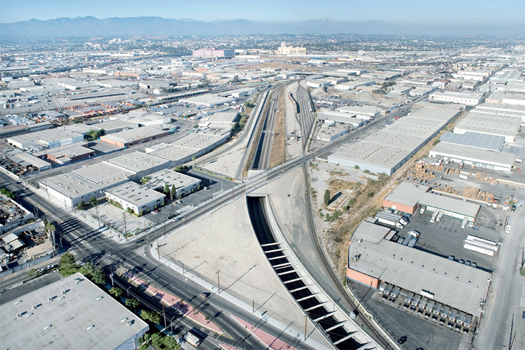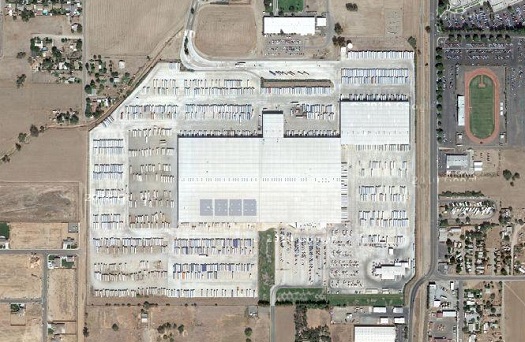We’re reading The Infrastructural City. This is week ten — after this, we’ve got Robert Sumrell’s “Props” next week and a brief return to the introduction the following week. Fill yourself in, if that’s necessary.

[An aerial shot of the Alameda Corridor amidst warehouses and distribution centers, from Lane Barden’s photo-essay “The Trench”, which follows “Distribution” in the text]
We’ve now reached the next-to-last chapter of The Infrastructural City, Deborah Richmond’s “Consumers Gone Wild: Distribution”. Richmond begins the chapter with a description of the “super-distribution centers” which dot the I-5 corridor between Los Angeles and San Francisco. When goods arrive at the Ports of Los Angeles and Long Beach — and vast quantities of goods arrive at those ports, which together “receive more than three times the cargo volume of the next largest American port, the port of New York and New Jersey” — they are often quickly shipped north up the Alameda Corridor:
“Running adjacent to Alameda Boulevard, the $2 billion, 23-mile-long open trench of the Alameda Corridor conveys trains from the Ports of Los Angeles and Long Beach to rail yards near the city’s downtown and on to points beyond in Kern County and the Inland Empire. Allowing double-height, stacked trains to pass while eliminating traffic conflicts at over 200 intersections between the ports and downtown, the corridor mitigates many drayage problems such as unfortunate collisions between passenger vehicles and trains full of televisions, blouses, and microcomputers… Roughly 60% of the goods coming through the Ports of Los Angeles and Long Beach are distributed to the Southern California region, while only one-third make their way onto local railroads (most notably via the Alameda Corridor) for distribution to the Midwest, South, and East Coast.
It is this character as a throughput city that has ultimately marked the landscape of Los Angeles more than water, more than cars, and more than movies. The transfer of shipping containers from ships to trains, trucks, container transfer buildings, retail outlets, and even homes, has been supported by a particularly voracious and narcissistic consumer whose ideal home is the city of Los Angeles itself, but whose influence radiates outward along truck routes and rail lines to the rest of the country.”
Unlike many of the previous chapters in the book, such as “Owens Lake” or “Gravel”, which were more strictly constructed as guidebooks to the infrastructural conditions of Los Angeles, “Distribution” continues to flit back and forth in this manner between descriptions of the spatial constructs of distribution1 and diatribes against the consumerist society that produces such spatial constructs. Those diatribes do over-reach in places — as in the case of the above claim that distribution has been the most significant marker on the landscape of Los Angeles, which seems an unnecessary claim in a text that serves as a single, long argument for the diversity of the infrastructural forces shaping Los Angeles. However, they are also often relatively cogent, as when Richmond argues that “the movement of consumer goods through the city” produces competition between humans and their future possessions, both “for open space on roads” (where relatively tiny passenger vehicles must navigate between “heaving eighteen-wheelers”) and in the genericization of the public realm (into a “transitory space of blind facades and low, blank walls”) in favor of private “control spaces of consumer constructs”.

[Wal-Mart distribution center in Porterville, CA, via Google Maps]
Perhaps the most interesting discussion in the chapter is the discussion of warehouses and “big box” stores, which, like the recent research on Wal-Mart presented at Places by architect Jesse LeCavalier, notes that these typologies are a peculiarly contemporary iteration of “architecture without architects”, guided not by vernacular building practices, but by spreadsheets and the demands of logistics:
“As William Mitchell observed, there exists in addition to all manner of “retail fronts,” a corresponding “architectural back” consisting of the supply chain infrastructure that allows goods to arrive on demand at specific, physical locations around the world. This architectural back has surpassed in cost and architectural importance any notion of a “front” for big box buildings. It is evident that more money is spent on the building envelope in terms of dock doors, special materials handling equipment, and site access to the rear of these buildings than is spent on the architecturally mediocre storefronts and office lobbies tacked onto the front of such buildings. One has only to pass along the loading-dock side of a warehouse or retail building to observe the subtle details that connect buildings to the supply chain. Attached by a weather-sealed gasket to the roll-up doors of the building, shipping containers come to rest.”
This also serves the reinforce one of the themes of Kazys Varnelis’s chapter, “Invisible City”: the importance of the architecture of the big box building as a cultural or formal performance pales in comparison to the importance of the building as a conduit for flows of materials and goods. These flows, and the logics of distribution and logistics that order them, are the “command line” of the infrastructural city. If architecture has something to say to the big box, it must be spoken in that language, as Richmond notes in reflecting on the (perhaps now thankfully dying?) trend towards architectural re-use of empty shipping containers:
“As a matter for architects to consider, the container itself is hardly interesting as an object retro-fitted for human habitation; rather, it is the extent to which more and more building types are being formatted with the specific aim of integrating fixed sites into the intermodal supply chain, or the extent to which buildings are already intermodal containers that pique our interest.”
As in the case of the container, the former tactic — considering the big-box as an object — is unfortunately the more common community tactic for dealing with typologies related to distribution. As laudable as the desire to reformat the big-box for urban locations is, reformatting alone may very well be futile, so long as it is practiced without interacting with the “capitalist dependency on efficiency and geo-economics” (Lateral, from their “Flatspace” project) so ably described by LeCavalier. (See, for instance, the way in which Vermont’s attempts to keep out Wal-Mart on the grounds of local preservation were circumvented and rendered irrelevant.) In that same piece, LeCavalier notes that focusing on new forms for the big box building or the strip mall without interacting with the logics of distribution and logistics that produced the original forms may not only be insufficient, but also missing more powerful opportunities:
The unintended result [of a community demanding purely formal modifications to new “urban” Wal-Marts] is a tacit endorsement of Walmart’s larger operations. But if communities and critics focused less on what the stores look like and more on what they do — less on form and more on performance — it’s possible that genuinely new formats might emerge, formats that would optimize urban settings in their handling of public space, infrastructure access, program mix, and so on.
If you’ve been following the Infrastructural City discussion and actually wading all the way through our extended ramblings, you’ve probably reached the end of this post and thought to yourself “well, that was mercifully brief”. You’re right, but you’re also wrong, because we’ll be back later in the week (well, probably this week) with posts on recent proposals for the architecture of distribution and a brief bit of commentary on the phenomenal flatness of Terminal Island.


hey, look at that, a link to my very first blog post ever. I forgot all about it.
The internet is forever.
Just to clear things up a bit. The WalMart distribution center pictured above is not in “Pottersville” but is in “Porterville”. Google it!!!!
I’m yelling at our resident Californian (that’s Stephen) for not pointing this out to me.
(Obviously, since the link is to Google Maps, I’ve already “Google[d] it!!!!” — the problem is with me transferring names sloppily, not a failure to consult the internet. The internet may be forever, but it can’t keep you from writing things down wrong.)
I accept full responsibility for poor copy editing .
[…] Mammoth here and F.A.D. […]
[…] thought that, having discussed distribution in a relatively abstract manner, it might be interesting to look at (and, to be clear, these are quick looks, not careful readings) […]
[…] and sister-visiting-from-Mongolia break) on the Infrastructural City, with two posts regarding “Distribution”: Brett Milligan contributes “The X-Ray of Retail”, which discusses the internal […]